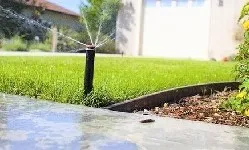
Water-wise gardening is about making smart choices to create a beautiful, sustainable landscape. It requires understanding your local conditions, soil, plants, and irrigation systems to maximize water efficiency. Following are a few actions you can take to decrease use of water while having a thriving garden.
Assess Your Current Water Use
In their 2020 Residential Water Use Study the Municipal Water District of Orange County
(MWDOC) found that, in Orange County the average residential water usage was around 75 gallons per person per day. Indoor water usage was between 55-58 gallons per person per day. Outdoor water usage varies by season and location peaking in July at 620 gal per household per day. Outdoor water usage accounted for approximately 50-70% of total water usage. Find out how much water your landscape currently uses. This will help identify areas for improvement.
Analyze the Space and Microclimates
Consider sunlight, shade, wind, heat, cold, soil type, drainage, slopes, low/high spots, and moisture sources. These factors can change seasonally—adjust your garden plan accordingly
Know Your Soil
The type of soil – clay or sandy – largely determines how often to water. Clay soils hold more water but absorb it slowly and also drain slowly when wet, so they require less frequent watering. Sandy soils drain quickly and may need more frequent watering. Amend sandy soils with organic matter to boost water retention. While amendments will not decrease the plant’s water need, they can usually increase the water-holding capacity of the soil and the interval between waterings.
Prepare and Improve Soil
Adjust soil pH as needed. Most soils in California are slightly alkaline. Test soil with a reliable test kit. Determine correct pH level for plants. For most drought-tolerant plants in Orange County, the ideal soil range is between 6.0 and 7.5. Add compost or organic matter to improve water retention and drainage. Thoroughly mix amendments into the top 12 inches of soil.
Rethink Your Lawn

Lose the lawn: Lawns are high-maintenance and water-intensive. Explore alternatives.
Limit turf: Use grass only where functional. It takes effort, resources and time to maintain. Mow high to encourage deeper, drought-tolerant roots.
Remove thatch: Excess thatch – the buildup of old grass roots, stems, and leaves – prevents water penetration.
Aerate to improve water absorption, especially in compacted or clay-heavy soils.
Choose Water-Efficient Plants
Select native or drought-tolerant species that thrive in the Orange County climate. Group plants by water needs (hydrozoning) and place them in suitable microclimates. Remember: Even drought-tolerant plants need regular watering until established.
Helpful Plant Resources:
- Arboretum All-Stars - UC Davis’ top 100 easy-care, water-wise plants.
- Arboretum All-Star Perennials
- Arboretum All-Star Shrubs and Trees
- Plant Safely in Drought Tolerant Landscapes - UC guide on potentially toxic plants
- WUCOLS Landscape Water-Use Planning Tool - Search California plants by water use.
Use the Right Irrigation System
Choose irrigation based on plant needs, soil type, and location (e.g., drip, micro-spray).
Water trees separately from lawns—less often, but more deeply.

Maintain and Adjust Irrigation
Check regularly: Look for leaks, overspray, or broken sprinkler heads.
Upgrade: Use low-flow sprinkler heads; convert shrubs to drip irrigation.
Time it right: Water early in the morning to minimize evaporation. Avoid windy periods.
Seasonal changes: Adjust timers as temperatures and daylight vary.
Optimize Watering
Water only as much as plants need. Gradually reduce watering times. For example, instead of irrigating for 15 minutes, decrease it to 6. Or decrease watering four days a week to two. Reduce fertilizer to slow plant growth and reduce water needs. Water deeply and infrequently to promote strong root growth. Use cycling and soaking on slopes or clay soils to prevent runoff.
Avoid watering impervious surfaces like sidewalks—check for unnecessary runoff.
Mulch and Compost
Apply 3–4 inches of mulch around plants, keeping it away from trunks. Mulch reduces evaporation, buffers soil temperature, and suppresses weeds. Use compost to help soil absorb and retain water. Apply it before mulching for best results.

Control Weeds
Weeds compete with garden plants for water and nutrients. Remove them early before they mature and spread.
Fertilize Wisely
Avoid over-fertilizing—too much nitrogen leads to excessive growth and higher water demands. Use slow-release or low-nitrogen fertilizers only when needed.
Prune with Purpose
Prune trees and shrubs only when necessary in order to avoid stimulating water-demanding growth. Pruning is best done during winter dormancy or early spring.
Conserve Water with Good Habits
Sweep, don’t spray: Use a broom instead of a hose to clean driveways and sidewalks.
